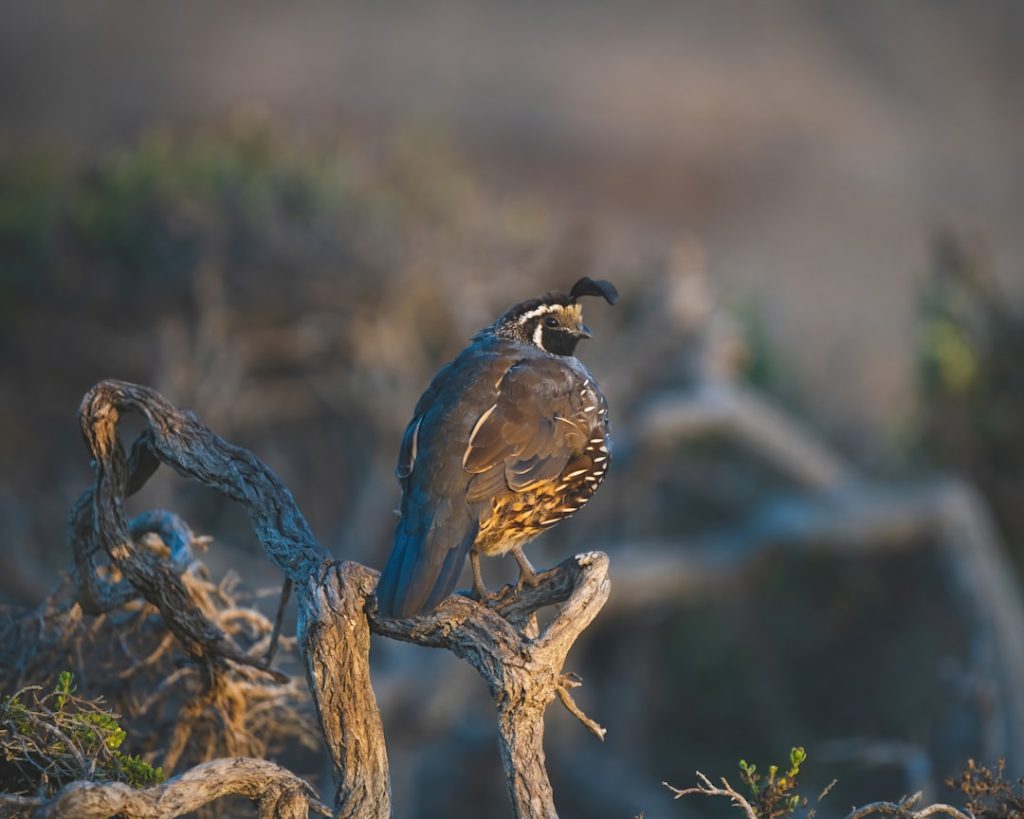Californian quail, also known as Valley quail, are popular game birds native to the western United States. They are known for their striking appearance, with a distinctive teardrop-shaped plume on their heads and a vibrant chestnut and black plumage. Californian quail are also prized for their delicious meat and are often raised for hunting purposes or as pets. Breeding Californian quail can be a rewarding and profitable venture for those interested in poultry farming.
Breeding Californian quail requires careful planning and attention to detail. It is important to select the right breeding stock, provide suitable housing and environment, and understand the breeding and incubation process. Additionally, caring for chicks and managing their health and disease prevention are crucial aspects of successful quail breeding. In this article, we will explore each of these aspects in detail, providing valuable insights and tips for successful Californian quail breeding.
Table of Contents
- 1 Selecting Breeding Stock
- 2 Housing and Environment for Breeding
- 3 Breeding and Incubation Process
- 4 Caring for Chicks
- 5 Health and Disease Management
- 6 Tips for Successful Californian Quail Breeding
- 7 FAQs
- 7.1 What is the breeding season for Californian quail?
- 7.2 How do Californian quail build their nests?
- 7.3 How many eggs do Californian quail lay?
- 7.4 What is the incubation period for Californian quail eggs?
- 7.5 How long does it take for Californian quail chicks to fledge?
- 7.6 What is the role of the male Californian quail in the breeding process?
Key Takeaways
- Californian quail breeding is a rewarding and relatively easy process for those interested in raising these birds.
- When selecting breeding stock, it is important to choose healthy, active birds with good genetic traits and no signs of disease.
- Providing a suitable housing and environment for breeding is crucial, including spacious cages, proper ventilation, and a balanced diet.
- The breeding and incubation process involves collecting and storing eggs, as well as using an incubator to hatch the eggs and care for the chicks.
- Caring for chicks requires a warm, clean environment, proper nutrition, and protection from predators.
- Health and disease management is essential for successful breeding, including regular health checks, vaccination, and quarantine procedures.
- Tips for successful Californian quail breeding include maintaining a clean environment, providing proper nutrition, and monitoring the birds for any signs of illness or distress.
Selecting Breeding Stock
Selecting the right breeding stock is crucial for successful Californian quail breeding. When choosing breeding stock, it is important to select birds that are healthy, vigorous, and free from genetic defects. Look for birds that are active, alert, and have good body conformation. Avoid birds that are too small or too large, as they may not be ideal for breeding purposes.
It is also important to consider the genetic diversity of the breeding stock. Inbreeding can lead to genetic abnormalities and reduced fertility, so it is important to introduce new bloodlines into the breeding stock periodically. When selecting breeding stock, look for birds that come from different sources to ensure genetic diversity within the flock.
Finally, consider the temperament of the birds when selecting breeding stock. Choose birds that are calm and docile, as aggressive or skittish birds may not be ideal for breeding purposes. By carefully selecting breeding stock based on health, genetic diversity, and temperament, you can lay a solid foundation for successful Californian quail breeding.
Housing and Environment for Breeding
Creating a suitable housing and environment for breeding is essential for the health and well-being of Californian quail. Quail are ground-dwelling birds and require ample space to move around and exhibit natural behaviors. When designing a breeding facility, consider providing at least 1 square foot of space per bird to ensure they have enough room to move around comfortably.
The housing should also provide protection from predators and the elements. Consider using wire mesh or netting to enclose the housing area and prevent predators from gaining access to the birds. Additionally, provide shelter from extreme temperatures and inclement weather by using insulated housing or providing shade during hot weather.
The environment within the housing should also mimic the natural habitat of Californian quail. Provide plenty of natural vegetation, such as grass and shrubs, to create hiding spots and nesting areas for the birds. Additionally, consider adding natural materials such as sand or gravel for dust bathing, which is an important behavior for quail.
Finally, ensure that the housing is well-ventilated to prevent the buildup of ammonia and other harmful gases. Proper ventilation will also help regulate temperature and humidity levels within the housing, creating a comfortable environment for breeding Californian quail.
Breeding and Incubation Process
Breeding Californian quail typically occurs in the spring and summer months when daylight hours are longer. To encourage breeding behavior, provide a diet high in protein and ensure that the birds have access to clean water at all times. Additionally, consider using artificial lighting to extend daylight hours, which can stimulate breeding behavior in quail.
Once breeding has occurred, collect the eggs daily to prevent them from being damaged or eaten by other birds. Store the eggs in a cool, humid environment until they are ready for incubation. The ideal temperature for egg storage is around 55 degrees Fahrenheit with a humidity level of 70-80%.
When it comes to incubation, Californian quail eggs typically take around 21 days to hatch. Use a reliable incubator with accurate temperature and humidity controls to ensure successful hatching. The temperature should be maintained at around 99.5 degrees Fahrenheit, with a humidity level of 60-70%. Turn the eggs several times a day to prevent the embryos from sticking to the shell membrane.
During the incubation process, monitor the development of the embryos by candling the eggs periodically. Candling involves shining a bright light through the egg to observe the development of the embryo inside. Remove any eggs that are infertile or contain dead embryos to prevent them from contaminating the rest of the batch.
Caring for Chicks
Once the chicks have hatched, it is important to provide them with proper care and nutrition to ensure their health and well-being. Transfer the chicks to a brooder with a temperature of around 95 degrees Fahrenheit for the first week, gradually reducing the temperature by 5 degrees each week until they are fully feathered.
Provide a high-quality starter feed specifically formulated for game bird chicks to ensure they receive the necessary nutrients for growth and development. Additionally, ensure that the chicks have access to clean water at all times, using shallow waterers to prevent drowning.
Monitor the chicks closely for signs of illness or distress, such as lethargy, huddling, or abnormal droppings. Address any health issues promptly by consulting with a veterinarian experienced in poultry care.
As the chicks grow, provide them with ample space to move around and exhibit natural behaviors. Consider introducing enrichment activities such as perches or hiding spots to encourage physical activity and mental stimulation.
Health and Disease Management

Maintaining the health of your Californian quail flock is essential for successful breeding and production. Implement a regular vaccination program to protect against common poultry diseases such as Newcastle disease and fowl pox. Consult with a veterinarian experienced in avian medicine to develop a vaccination schedule tailored to your specific needs.
In addition to vaccinations, practice good biosecurity measures to prevent the introduction and spread of diseases within your quail flock. This includes limiting access to your facility, disinfecting equipment and footwear, and quarantining new birds before introducing them to your existing flock.
Monitor your quail regularly for signs of illness or disease, such as decreased egg production, abnormal droppings, or respiratory symptoms. Address any health issues promptly by consulting with a veterinarian experienced in poultry care.
Provide a clean and sanitary environment for your quail by regularly cleaning and disinfecting housing areas, feeders, and waterers. This will help prevent the buildup of harmful bacteria and parasites that can compromise the health of your flock.
Tips for Successful Californian Quail Breeding
– Provide a balanced diet high in protein to support breeding behavior and egg production.
– Monitor environmental conditions such as temperature and humidity to create an optimal breeding environment.
– Select breeding stock based on health, genetic diversity, and temperament.
– Implement good biosecurity measures to prevent the introduction and spread of diseases within your quail flock.
– Provide proper care and nutrition for chicks to ensure their health and well-being.
– Consult with a veterinarian experienced in avian medicine for guidance on vaccination programs and disease management.
– Monitor your quail regularly for signs of illness or distress and address any health issues promptly.
– Create a clean and sanitary environment for your quail by practicing regular cleaning and disinfection protocols.
In conclusion, breeding Californian quail can be a rewarding venture for those interested in poultry farming. By carefully selecting breeding stock, providing suitable housing and environment, understanding the breeding and incubation process, caring for chicks, and managing their health and disease prevention, you can lay a solid foundation for successful quail breeding. With proper planning and attention to detail, you can enjoy a thriving flock of Californian quail while reaping the benefits of their delicious meat or enjoying them as pets.
If you’re interested in breeding Californian quail, you may also want to learn about the best vegetables to feed them. Poultry Wizard has a helpful article on what vegetables quails eat, which provides valuable insights into their dietary needs. Understanding their nutritional requirements is essential for successful breeding and raising of these beautiful birds.
FAQs
What is the breeding season for Californian quail?
The breeding season for Californian quail typically occurs from late spring to early summer, with peak breeding activity in May and June.
How do Californian quail build their nests?
Californian quail build their nests on the ground, often in a shallow depression lined with grass, leaves, and feathers. The female quail typically constructs the nest and incubates the eggs.
How many eggs do Californian quail lay?
A female Californian quail can lay anywhere from 12 to 16 eggs in a single clutch, with an average of 14 eggs being common.
What is the incubation period for Californian quail eggs?
The incubation period for Californian quail eggs is approximately 21 days, during which the female quail will diligently sit on the eggs to keep them warm.
How long does it take for Californian quail chicks to fledge?
Californian quail chicks typically fledge, or leave the nest, within a few hours of hatching. They are precocial birds, meaning they are born with their eyes open and are able to leave the nest shortly after hatching.
What is the role of the male Californian quail in the breeding process?
The male Californian quail plays a role in protecting the nesting female and the eggs from potential predators. He may also help with feeding and caring for the chicks once they hatch.
Meet Walter, the feathered-friend fanatic of Florida! Nestled in the sunshine state, Walter struts through life with his feathered companions, clucking his way to happiness. With a coop that’s fancier than a five-star hotel, he’s the Don Juan of the chicken world. When he’s not teaching his hens to do the cha-cha, you’ll find him in a heated debate with his prized rooster, Sir Clucks-a-Lot. Walter’s poultry passion is no yolk; he’s the sunny-side-up guy you never knew you needed in your flock of friends!







